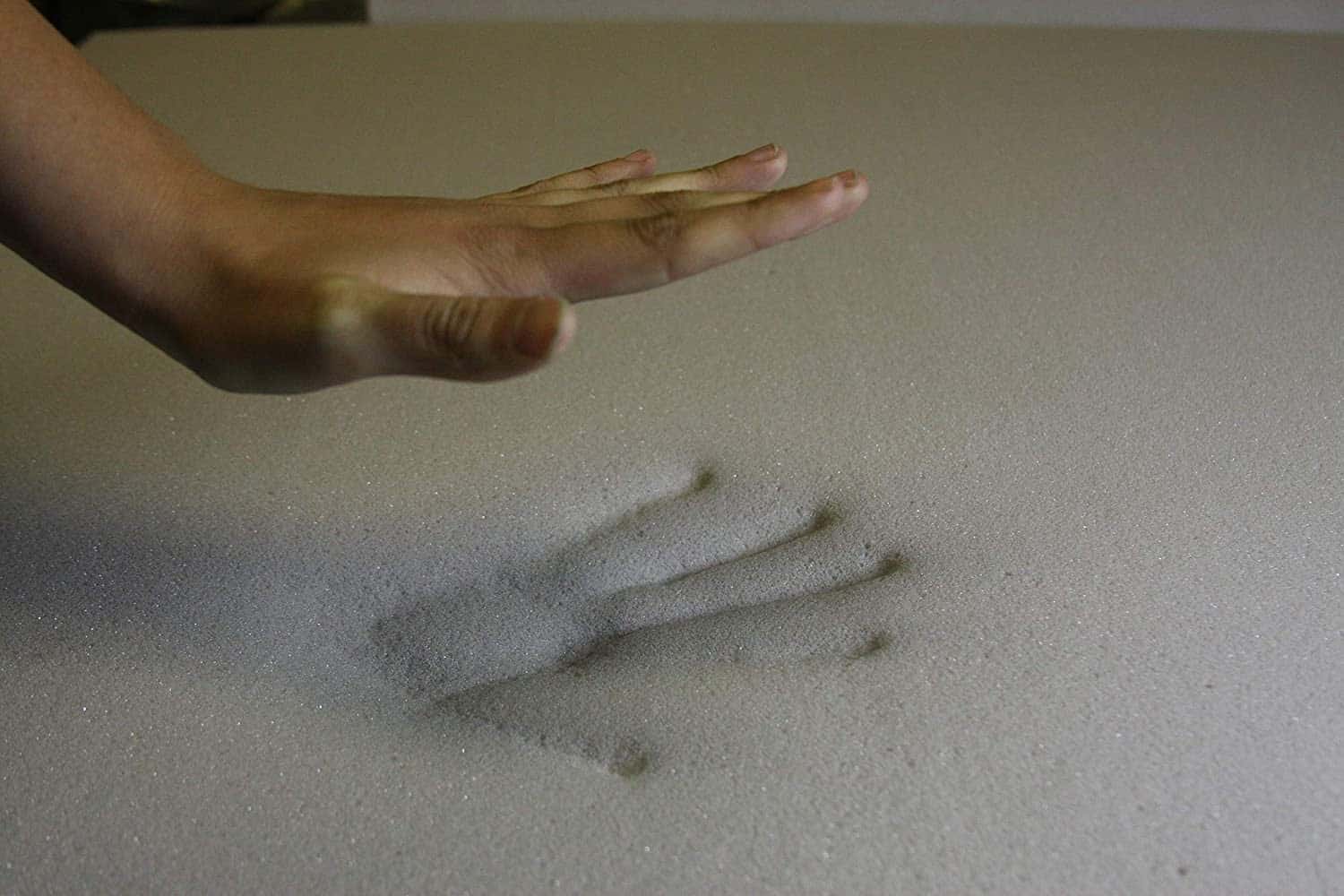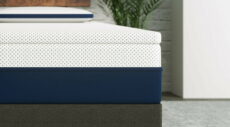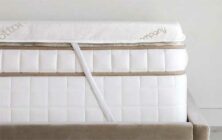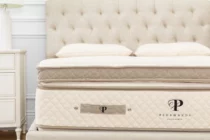A mattress topper serves as an extension to the mattress, providing it with extra cushioning and support. If your existing mattress needs a pick-me-up, a mattress topper can give it a new lease on life, or serve as an alternative to buying a brand new mattress. The additional layer on an old mattress may firm it up and provide extra support. Mattress toppers come in various thicknesses and densities. This mattress topper density guide will help you determine the level of support the topper can deliver.
A mattress topper’s density is directly related to the amount of support it offers, a higher density topper will provide more support. A memory foam mattress topper with a density of 3-4 lbs per cubic ft. provides average support. A memory foam mattress topper with a density of 5 lbs per cubic ft. and higher provides greater support but poorer ventilation.
3 best high-density toppers we tested (Saatva latex one is the more dense)
The density of a material is defined as its mass per unit volume. In layman’s terms, this describes how tightly the matter is compacted. You can learn more about the density of a material in this article from Harvard University’s Casual Patterns In Science.
Higher-density toppers tend to be more temperature-sensitive, meaning that they take on a rather viscous feel as they warm up and soften. Some sleepers enjoy this feeling of being contoured and cradled, while others feel as though they’re trapped and sinking into the bed. These types of mattress toppers don’t return to their original shape quickly, making it difficult for people who change positions while they sleep. Lower density foam mattress toppers are not as sensitive to temperature, spring back faster, and cause fewer problems for sleepers who move around a lot.
Read further for an in-depth look at mattress topper density and how to choose the best mattress topper density for your body type and sleep style. Also make sure to check out our guide to find out the differences between a mattress topper vs mattress cover for additional information.
A Key Topic for This Mattress Topper Density Guide – Indentation Load Deflection
As part of reading this mattress topper density guide, you’ll learn that many people who believe that a higher mattress topper density alone is an indication that a mattress topper will be harder and firmer than one with lower mattress topper density are incorrect. The Foam Indentation Load Deflection (ILD) determines mattress topper firmness, as well as how much weight is required to indent it. If you want to know more about ILD, check out this article from Ergoflex. You can use the Mattress Topper Density and the Indentation Load Deflection together for a better understanding of which mattress topper is right for you.
Together, the density of a memory foam mattress topper and its Indentation Load Deflection (ILD) will give a comprehensive view of its overall feel. For example, in a latex mattress topper, a higher ILD typically indicates a higher density. The ILD indicates the mattress topper’s firmness along with the weight that is required to make an imprint.
While a high-density mattress topper provides more body contouring, the increased density also gives more support, pushing the sleeper upwards even as it hugs their body. This greater degree of support may be why a higher density mattress topper rates better for back pain relief than their low-density counterparts. Read our article on how to choose a mattress topper for back support to find out how a mattress topper can relieve back pain.
Here are some examples of different mattress toppers materials and their equivalent densities:
| Material | Typical Mattress Topper Density Range | Mattress Topper Example + Link | Price of Product |
| Memory foam | 4 to 5 pounds | Zinus memory foam mattress topper | ~$100 |
| Gel foam | 4 to 5 pounds | Linenspa gel-infused mattress topper | ~$60 |
| Latex | 3 to 4 pounds | Pure Green 100% natural latex topper | ~$280 |
| Down | 3 pounds generally | Amazonbasics down mattress topper | ~$35 |
| Wool | 3 to 4 pounds | Sleep&Beyond wool mattress topper | ~$290 |
How Can You Choose The Right Mattress Topper?
Choosing the right mattress topper will depend on your personal sleep preferences and the condition of your existing mattress. Read our ultimate mattress topper guide to learn more about the thickness and density of toppers and how these factors influence the way the mattress topper feels.
When choosing the right mattress topper, consider a thick mattress topper to cover lumps and make the bed warmer, pick a denser mattress topper to relieve pain, and select gel-infused memory foam or latex to cool you down. These tips will help you find what’s right for you.
Step 1. Choose a Thick Mattress Topper to Cover Lumps and Make the Bed Warmer
The thinnest mattress toppers are about an inch thick, while the thickest can measure about four inches. A good mattress topper should be sufficiently thick. If it is too thin, it will not cover up the lumps on your bed and will not be able to play its intended role. If you desire more warmth at night, consider buying a thicker topper as they make the bed warmer. A thinner mattress topper works well if you have minor issues to cover. Read our in-depth guide on mattress topper thickness and size to help determine what mattress topper will suit your needs best.
Step 2. Consider a Denser Mattress Topper to Relieve Pain
The density of the mattress topper is not the same as its thickness. Density determines the level of support a topper will provide—the higher the density, the more supportive the mattress topper. A mattress topper with a density of two pounds provides low levels of support, while one with a density of four pounds suits people who want significant relief from pain and discomfort. Choose the density that best suits your requirement. For example, to maximize pain relief and comfort, choose a mattress topper density between 4-5 pounds per cubic foot. This 4-pound density mattress topper from Amazon reduces pressure points to ensure a good night’s sleep.
Step 3. Select Gel-Infused Memory Foam or Latex to Cool You Down
Different materials will provide comfort depending on what you need in a mattress topper. Most mattress toppers are made using cotton, latex, memory foam, egg-crate foam, or wool. Consider all factors before choosing the right material for you. For example, if you have allergies and problems with bed bugs, your best choice would be a wool mattress topper. If your main concern is improving comfort, you will be better off with memory foam products. If you are looking for a mattress topper to cool you down, try gel-infused memory foam or latex. Choose the mattress topper according to your specific sleep needs and the comfort issues you face during the night.
Additionally, make sure to take a look at our article on how to choose a mattress topper for camping for some portable suggestions.
Memory Foam Density Chart for Mattress Toppers
As an example, here are three memory foam mattress toppers and their densities:
| Product example from Amazon | Density (lb per sq. ft) | Density (kg/m3) | Density (g/cm3) | What does it feel like? | Price of Product |
| Perfect cloud mattress topper | 3 or under | 48.06 | 0.048 | It is less dense, therefore it can be comparatively less effective | ~$130 |
| Lucid mattress topper | 4-5 | 64.07 | 0.064 | Comparatively more comfortable and softer | ~$100 |
| Sleep Innovations mattress topper | 5 or above | 80.09 | 0.08 | Soft and comfortable with breathable protection | ~$150 |
What’s the Density of Tempurpedic Foam?
When Tempur-Pedic emerged in the early 1990s as a household brand name, they became famous for their viscoelastic polyurethane foam. This foam is the foundation of Tempur-Pedic’s patented memory foam construction and introduced the world to “a better night’s sleep”. Tempur-Pedic utilizes a layered construction in their mattress topper, offering three inches of Tempur material, the same material that goes into their mattresses.
The density of Tempurpedic foam ranges between 4.5 and 5.34 pounds per cubic foot. However, it might vary in some cases depending on the brand, texture, and other factors.
You can read all about Tempur-Pedic’s mattress topper here. Tempur-Pedic has many different mattress pads and toppers to meet the comfort needs of their consumers and offers a 10-year warranty.
What Are the Benefits of a Five-Pound Per Sq. Ft. Density Memory Foam Mattress Topper? Where Can I Find One?
A high-density memory foam, such as five-pounds per sq. ft., carries a lot of benefits. In high-density foam, there are billions of small, open cells (bubbles with holes in them), tightly packed together. When you lie down on a high-density foam mattress, air flows slowly between the bubbles giving it time to gently cradle the natural shape of your body, distribute your weight, and relieve pressure. Read our article about gel vs. memory foam mattress toppers to find out these toppers contour to the shape of a resting body and relieve pressure.
The benefits of a five-pounds per sq. ft. density memory foam mattress topper include prolonging the life of your bed, retaining your bed’s original shape, and encouraging breathable comfort and protection while you’re sleeping.
High-density foam has more body, so it provides extra cushion and better support. It conforms precisely to your body and slowly regains its original shape when you move. You may have seen this in advertisements, where the hand imprint goes away after a few seconds. You don’t sink right through a high-density memory foam mattress nor do you risk bottoming out.
Top manufacturers use a dense cell structure in foam mattress toppers that will support you while you sleep and last for a long time. Mattress topper materials like Luffa are lightweight but firm, giving you the support you need. You can read all about Luffa in this article titled, “Effect of softening treatments on the properties of high-density cylindrical luffa as potential mattress cushioning material.”
High-density foams, like Visco, also have a longer memory. The longer recovery from a compressed state makes a Visco memory mattress more supportive. The high-density foam softens more slowly in response to body heat making it feel more gentle and malleable. We like this ViscoSoft mattress topper from Amazon because it also comes with a machine washable cover.
High-density Visco foam is also more expensive to make because it’s made out of a raw material called resin. This explains why a top brand memory foam mattress is so expensive. You can learn more about Viscoelastic foam here.
How Can You Soften a Mattress with a Memory Foam Mattress Topper?
Buying a mattress topper is one of the quickest, most effective, and cheapest ways to make a hard surface softer. There are different materials available, including latex, memory foam, wool, cotton, feather, polyfoam, and down alternative. The most popular option is memory foam—which needs to expand before use. Read our article on how long it takes a memory foam mattress topper to expand to find out the recommended time to wait before you sleep on the memory foam topper.
To soften a mattress, choose a memory foam mattress topper that is made of memory foam with a thickness of three to four inches, and a density of about five pounds per cubic foot.
By adding a supportive layer to the top of your bed, you can improve pressure point relief and contouring. When using a memory foam mattress topper to soften a mattress, get something that is under two inches thick and a lower density for extra softness, like this one.
How Can You Make a Mattress Firmer with a Mattress Topper?
If a mattress that’s too soft is preventing you from restful sleep you might need a thicker mattress topper with a high density. Read our article about mattress topper hacks where we discuss methods to make a mattress feel firmer.
To make a mattress firmer, choose a mattress topper that is made of latex material, with a thickness of two to three inches, and a density of five pounds per cubic foot.
A mattress that is too soft won’t properly support and cradle a sleeping body and will cause body aches. Read our article on how to choose a mattress topper for hip pain to find out more about the support that a mattress topper can provide.
Make sure to also read our article on how to fix a lumpy mattress topper for some additional tips and tricks.
In a Nutshell
A mattress topper with a higher density will provide greater support because of its ability to contour to the body during sleep, and evenly distribute weight across its surface. Read our article on how to choose a mattress topper for a heavy person to find out more about mattress toppers with higher durability and load-bearing capacities.




